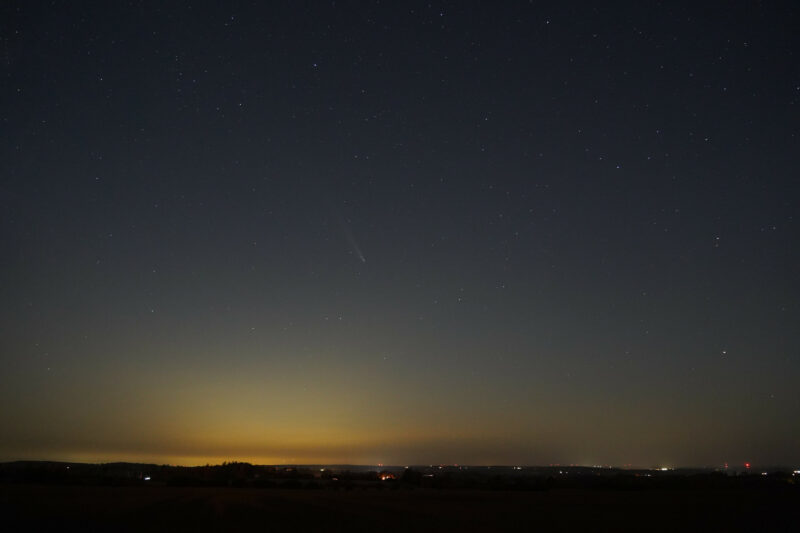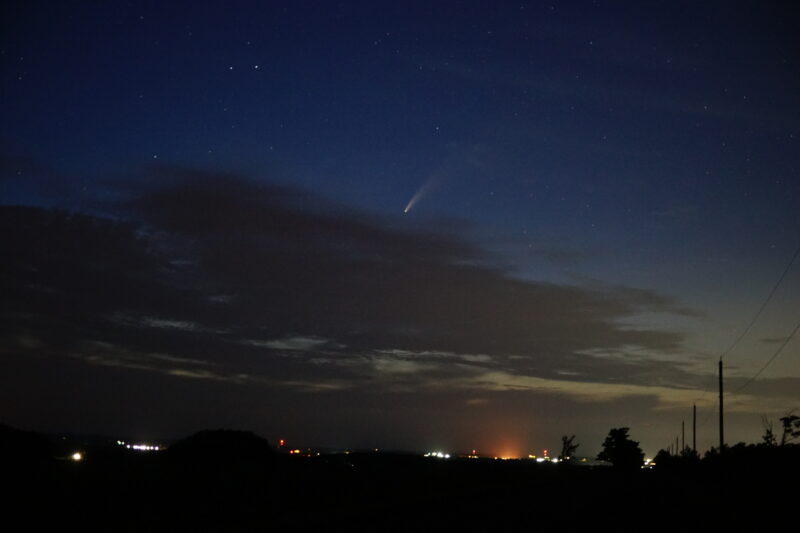
You always have to take media reports about full moons and comets with a grain of salt: super moons aren’t all that super, blue moons aren’t blue, and comets of the century usually aren’t. This year’s “comet of the century,” Comet Tsuchinshan-ATLAS wasn’t visible to my unaided eyes any night this week in Toronto. It’s possible that other people had more luck. The comet was super-easy to pick out in binoculars, with the added benefit of being visible from our front window—I didn’t even have to go outside to see it! On Wednesday evening there were a couple of dozen people at the Chester Hill lookout chatting excitedly and armed with all manner of compact telescopes, cameras, and binoculars trained on the same corner of the sky. Tonight’s picture was taken in the darker skies of East Dodgeville.
Scores for Tsuchinshan-ATLAS:
Cool factor of being able to see a comet in light-polluted city skies: +5
Bringing out the community: +2
Viewing from inside the house (no-pants bonus): +1
Lack of unaided-eye viewing: -1.5
Overall Comet of the Century score for Tsuchinshan-ATLAS: 6.5

Comet NEOWISE from 2020 is the defending champion for Comet of the Century. Because of the timing of this one, I didn’t have a chance to see it from Toronto skies. One big difference between NEOWISE and Tsuchinshan-ATLAS is that the former was easily visible to the unaided eye at a dark(ish) sky site. It was definitely the brighter comet, with both head and tail visible without binoculars or a long camera exposure.
Scores for NEOWISE:
Unaided-eye viewing: 9
Overall Comet of the Century score for NEOWISE: 9
Yeah, there’s just the one score for NEOWISE, because really, what else would a comet of the century be if not immediately in your face when you look up? With NEOWISE, you needed to know where to look, but once you saw it, you couldn’t lose it again.
Comet of the Century winner, and still undefeated: NEOWISE.
Bring on the next contender! Seeing comets never gets old.
I think it must be very location dependent. I took dozens of photos of NEOWISE from northern Arizona, and it was easily visible to the naked eye, but I heard a lot of people say they could not see it from other parts of the country. I have now taken dozens of Tsuchinshang-Atlas shots from the light polluted skies south of Denver CO, and I can also see it by eye here if I get just outside the cities, but it is not as easily seen as NEOWISE was. NEOWISE had the second dust tail more distinctly, Tsuchinshang has the anti-tail. Tsuchinshang definitely has a longer tail. When I compensate for light pollution, I think it is about a tie.
Hmm, interesting! I still have to give it to NEOWISE, but everyone can make their own judgement in this very subjective race. Still lots of time this century for another entrant. 🙂